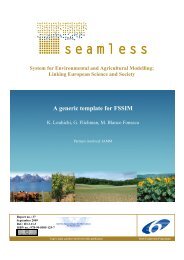Farming Systems Design 2007 - International Environmental ...
Farming Systems Design 2007 - International Environmental ...
Farming Systems Design 2007 - International Environmental ...
You also want an ePaper? Increase the reach of your titles
YUMPU automatically turns print PDFs into web optimized ePapers that Google loves.
<strong>Farming</strong> <strong>Systems</strong> <strong>Design</strong> <strong>2007</strong><br />
Field-farm scale design and improvement<br />
year -1 ) and + 74% (from 7 to 27 t ha -1 year -1 ), while the increment was + 43% (from 29 to 51 t ha -1<br />
year -1 ) in miscanthus. In the maturity stage (year 2-7) differences in yield production levels have<br />
been observed among the three species, with 46 t ha -1 in giant reed and –30% and –66% dry yield<br />
in miscanthus and cardoon respectively. From year 8-12 a decreasing production trend was<br />
observed in each crop, however differences in the yield level have been recorded (28 t ha -1 year -1 in<br />
giant reed and -18% and – 57% in miscanthus and cardoon respectively). All the three perennial<br />
crops were characterized by a favorable energy balance along the overall lifecycle (Table 1).<br />
During the field trial the total energy input was the same for the three species because identical<br />
management practices were applied. Soil tillage and planting were the main energy input in the<br />
crop establishment, while fertilisation and harvest represented the unique energy input from the 2 nd<br />
year onward. For this reason the total energy input changed from 15.3 GJ ha -1 in the establishing<br />
year to 11 GJ ha -1 in the following years. The energy output showed different values for each crop<br />
and giant reed energy output was higher than<br />
60<br />
giant reed miscanthus and cardoon. Moreover, the two<br />
miscanthus<br />
rhizomatous species are characterized by an<br />
cynara<br />
50<br />
energy efficiency and energy balance more<br />
favourable than cardoon (Table 1). The net<br />
37<br />
40<br />
energy yield of the overall lifecycle was 605 and<br />
446 GJ ha -1 for giant reed and miscanthus<br />
30<br />
27<br />
respectively against 258 GJ ha -1 of cardoon.<br />
Dry yield (t ha -1 )<br />
20<br />
10<br />
0<br />
1st 2nd 3rd 4th 5th 6th 7th 8th 9th 10th 11th 12th<br />
Years<br />
Figure 1. Above-ground dry yield of giant reed,<br />
miscanthus and cardoon from the crop<br />
establishment to the 12 th year of growth in<br />
comparison, for each species, with the mean<br />
value.<br />
18<br />
Conclusion<br />
Giant reed and miscanthus confirmed their better<br />
production performances than cardoon in term of<br />
biomass yield and net energy yield. However,<br />
cardoon crop efficiency could be increased testing<br />
other genetic sources under different<br />
management practices. The possibility to cultivate<br />
different biomass crops in the same land area<br />
allow to expand feedstock supplies minimising<br />
their negative impact on soil fertility and<br />
biodiversity. In order to improve the biomass<br />
resources in Europe, biomass systems should not be based on a singles feedstock type but on<br />
regional capability and specification. According this approach the present research has assessed a<br />
long term availability of complementary crops maximizing the yield on land area within sustainable<br />
agro-biomass systems.<br />
Table 1. Global energy balance for giant reed, miscanthus and cardoon from the crop<br />
establishment to the 12 th year of growth.<br />
Input<br />
(GJ ha -1 )<br />
Output (2)<br />
(GJ ha -1 )<br />
Energy<br />
efficiency<br />
Net energy yield<br />
(GJ ha -1 )<br />
G (1) M (1) C (1) G (1) M (1) C (1) G (1) M (1) C (1)<br />
Year 1 15.3 479 166 109 31 11 7 464 150 94<br />
From 2 nd to 7 th 11 760 565 367 69 51 33 749 554 356<br />
From 8 th to 12 th 11 408 387 183 43 35 17 460 376 172<br />
Mean 590 457 269 55 41 24 605 446 258<br />
(1)<br />
G=Giant reed, M=Miscanthus, C= Cardoon; (2) Calculated as product of dry yield and calorific value 16.7, 16.9<br />
and 14.9 MJ kg -1 for giant reed, miscanthus and cardoon respectively.<br />
References<br />
G. L. Angelini et al., Biomass yield and energy balance of giant reed (Arundo donax L.) cropped in central Italy as related<br />
to different management practices, 2005a. European Journal of Agronomy 22(4), 375-389<br />
G.L. Angelini et al., Long term evaluation of biomass production of giant reed (Arundo donax L.) to different fertilisation<br />
input, plant density and harvest time in a Mediterranean environment, 2005b In: Proceeding of 14 th European Biomass<br />
Conference and Exhibition, Paris, October 17-21, 2005, p. 141-144<br />
I. Lewandowski et al., 2003. The development and current status of perennial rhizomatous grasses as energy crops in<br />
the US and Europe. Biomass & Bioenergy 25, 335–361<br />
J. Fernández et al., Industrial application of Cynara cardunculus L. for energy and other uses, 2006. Industrial Crops and<br />
Products 24, 222-229<br />
- 44 -




